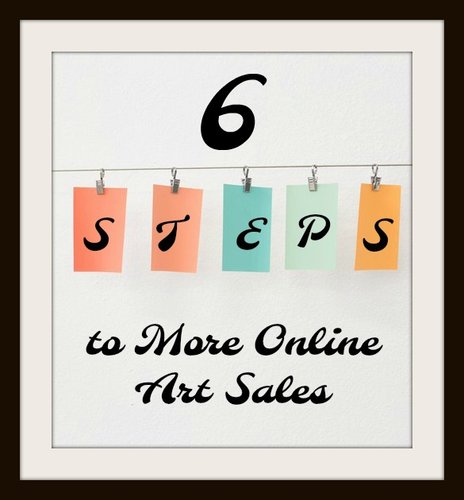by Carolyn Edlund
Selling art online? Want to get more traffic, more interest and more online art sales?

If you’re feeling frustrated because online art sales aren’t coming easily, you are not alone. It’s very common for artists to experience low or even nonexistent sales on their websites, even when other methods of selling art are working for them. So why does this happen? There are several reasons why online sales can lag:
- Website traffic is slow, with few visitors seeing your work.
- Your website does not give customers the same shopping experience that face-to-face selling does.
There is no substitute for prospective customers seeing your work in person. You have more resources in a setting where people can see art up close and handle it, or even try it on (if it’s wearable.) Placing work in someone’s hand is a powerful selling strategy that can make a huge difference. Without the ability to meet your customer in real life, you can use techniques online that enhance the shopping experience and increase your sales.
Step #1 – Bring more traffic to your site
Getting eyes on your art website is half the battle, because there are millions of options for anyone surfing the internet. Getting found through search is one way that artists can pull traffic. However, that can be hard, because popular keywords (like “landscape painting” or “silver jewelry”) direct shoppers to major sites that take up all the oxygen in the room. Small websites like yours can stand out more effectively by using “long tail keywords” that are more specific. This Shopify article gives the details.
Other methods of driving traffic are through social media marketing and email marketing to your customer/prospect list. In addition, work on gaining backlinks from other sites to feed into yours.
Step #2 – Make sure your website is welcoming
Ever been to a website that looked out-of-date and was hard to use? Visitors click away almost immediately from sites that are not inviting places to shop. A website that is poorly presented also doesn’t inspire trust. Trust is essential if you expect people to shop for your work confidently and use credit cards to pay you.
Web designer Bethany Feltz of Typework Studio says, “One thing that is important for any artist to have is a unique site that showcases their art work to fullest potential. A well-designed site will drive sales and pay for itself, while establishing credibility for you as a serious artist.”
An appealing website layout with professional presentation, intuitive functionality and an easy method of checkout will smooth the way for people who visit your site to begin to learn more about you and your work. Think about websites where you shop. What is welcoming, friendly and interesting about them? How does your own site compare, and how might you improve it?
Step #3 – Use excellent photos and lots of them
Without the benefit of showing your art or handmade work in person, you must have outstanding images that do the job for you online. All artists should present excellent images of their work. But when offering work for sale, you need a sufficient number and type of images to allow the shopper to truly experience your art.

Encaustic artwork by Heather Davis shown in situ
Visit any shopping site and look at products for sale. Notice how many views are shown of each item. Multiple views enhance the shopping experience and allow customers to virtually “try on the item” as they gain visual information. For artists, this means offering a clear image of the art that can be enlarged, plus detail shots that share a close-up look and in situ photos that show the art in an environment where it belongs. In situ shots give visual cues about the size, scale and impact of your work in a room. In addition, they help the viewer imagine placing your artwork in their own space. This is important in moving the shopper along in the sales process. Showing wearable art on a model also falls under this category.
Work in progress photos are also helpful, because they share the intricate techniques and steps you take in the studio. Use of these photos can help the customer understand the complexity and amount of work in any given piece of art. They can even build perceived value and justify your prices. In progress shots (or videos) are often used on website “About” pages.
Step #4 – Communicate clearly
Why should a website visitor be interested in what you make? Customers care primarily about themselves. Therefore, written content on your website should speak clearly to them, in terms of what they care about and value. As the artist, you should be aware of how your work reaches people emotionally. Why do they buy? How does your work make them feel?
The artist story is a powerful vehicle for sharing this type of information. Your story should be constructed to reach out to your chosen market. In that way, the reader is able to relate to it and be drawn into the concept behind your work and individual pieces.
Written information about each work of art for sale is extremely important, too. Title, medium and size are key, but have you shared the inspiration behind the art? Does your painting or sculpture depict a particular place or memory? Your written descriptions should be carefully constructed to share the features and the benefits of the work, or even tell a story about it. What does your customer need to know that will make purchasing your art a desirable and exciting experience?
Step #5 – Answer their questions
Here’s where many artists forget what customers need in order to make a purchase. Often, artists say nothing (or very little) about the purchasing process itself and logistics. How long does it take to ship your work? What is the shipping cost, or is it free? Do you take returns? Do you make custom work or take commissions? Can the item be drop-shipped to another address if the purchase is a gift? Is the item hand washable? Can the art be placed in direct sunlight? All these questions and more are often left unanswered. The shopper does not have the confidence to buy because they simply do not have enough information. The result: no sale.
Put yourself in your customers’ shoes. Try to imagine the questions they have about buying and owning your work. Visit shopping sites to see what they share with visitors, and consider how you might translate that to your own small business. Then, create a FAQ page on your own art website. Share your contact information (phone and email) so you can be available for customer inquiries or questions.
Step #6 – Bring visitors back to your art website again
One of the most important things you can do through your art website is to capture email addresses that will allow you to stay in touch with visitors. Bring them back again and again to your site through email marketing campaigns that share your story and present artwork to your audience. It usually takes numerous “touches” to make a sale. This follow up activity allows you to take advantage of the hard work you undertook in attracting website traffic in the first place. And, it gives you a chance to close sales after the first visit.
Marketing is hard work, and for many artists, it takes 30-50% of their time. Create a marketing calendar to motivate yourself, and be persistent. It takes time to increase website traffic, but once you have done so, your work gets a lot more exposure. Making your website more “customer friendly” will help you make sales to those visitors.
Doing business as an artist is challenging, and there are a lot of moving parts. Your art website can be an effective ancillary channel to in-person selling. Websites provide a way for sales to happen when you are not in front of the customer. Using these six steps will help you create an exciting shopping experience and make it easy for website visitors to say “yes” to the sale.


I agree with every artist at least have one site to showcase their arts. I prefer Masterpieceonline sites to sell my art online.